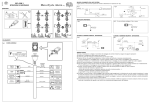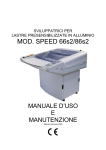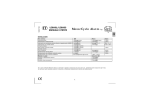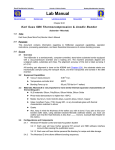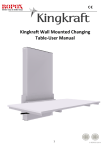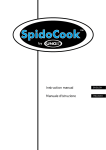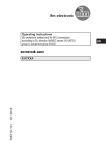Download - DSOUND
Transcript
DEF•COM 3 INSTALLATION MANUAL MotorCycle Alarm IMMOBILISER (FAIL SAFE SYSTEM) Positive Logic (the relay switches over when the central unit is disarmed and ignition +15 is present.) by Fig.2 +15 H2O + Ignition pack, coil, petrol pump grey NO C 10 AMP RELAY DEF-COM central unit NC KO OK 86 85 grey From the magneto NO 87 87/A NC 30 C dark blue INSTALLATION SUPPLEMENTARY RELE' SUPPLEMENTARE RELAY Fig.3 ✄ EN + 15 BLOCCHETTO IGNITION CHIAVE KEY SWITCH AVVIAMENTO SWITCH PROTECTION Fig.4 blu C NO NC COIL RELAY DEF-COM central unit Fig.5 If not used, connect the wire to an earth point purple 80°C yellow/green SWITCH TO BE INSTALLED SWITCH TO BE INSTALLED KO OK <±45° ↕ >±45° ↕ HORN WITH POSITIVE CONTROL – SUBKEY Fig.6 HORN WITH NEGATIVE CONTROL – SUBKEY +12V Fig.7 +12V IGNITION KEY SWITCH ORIGINAL CONTROL SUPPLEMENTARY RELAY Fig.1 GENERAL WIRING DIAGRAM IGNITION KEY SWITCH HORN TO THE ORIGINAL CONTROLS P600 DIODES to be installed DIRECTION INDICATORS SUPPLEMENTARY RELAY HORN brown ORIGINAL CONTROL +12V light blue +12V CONNECTIONS brown ANTENNA (do not cut and do not tape together with rest of cable harness) Negative supply (-) BLACK RED RED LIGHT BLUE Direction indicators LIGHT BLUE BLACK BROWN DARK BLUE (C) Immobiliser Positive supply (+12V) WHITE LED Negative command of horn relay Mount 15A fuse Ignition switch positive supply (+15) ORANGE YELLOW/GREEN GREY (NO) NC PURPLE Protection against removal of earth connection (connect to earth if not used) Protection for NO earth contact FINAL CHECK When installation is complete and the harness connector has been connected to the alarm central unit, proceed as follows: 1. re-connect the battery of the machine. 2. Turn the machine’s ignition key ON and then OFF again 3. 50 seconds later, the immobiliser will automatically arm: the direction indicators flash briefly once, the siren beeps once and the LED starts to flash very slowly. 4. Disarm the alarm system using the remote control: the direction indicators flash once, the siren beeps once and the LED switches off. 5. Within 50 seconds turn the machine on to check that the connections made are operating correctly. 6. Switch the engine off and turn the machine’s ignition key OFF. Arm the alarm system within 50 seconds: the direction indicators flash twice, the siren beeps twice and the LED flashes, with very brief switches off. 7. During the initial 26 seconds immunity period, do the following tests which should provide a BEEP if they have a positive result: a. Turn the machine’s key ON. b. Activate any switch protection (opening of the saddle compartment, removal of the firewall, …) c. Move the machine to activate its tilt protection. The timing of the immunity period is reset every time a beep is heard. 8. Once the immunity period is over, the LED flashes with an reversed sequence (long switches off) and the alarm system will be triggered for one 26 sec. cycle by the activation of any of the protection switches, or by turning the machine’s key ON, by moving the machine0: the siren will produce its distinctive, modulated sound, the direction indicators flash and the horn (if connected) will sound intermittently. Check the engine immobiliser operates correctly during the alarm cycle. 9. When the alarm system is disarmed, the LED will remain on and the siren will emit a BOOP sound to signal that it has memorised an alarm trigger: refer to the user manual for the code of this signal and for all other features/settings of the product.. V81096B Istr.Uso Def-Com3 EN 28-07-2006 DEF•COM 3 OPERATION MANUAL 9:29 Pagina 11 MotorCycle Alarm by SIGNALS STATUS OF CENTRAL UNIT Passive arming Arming by remote control Arming without internal lift and tilt sensor Arming with open contact Initial immunity phase Testing during the initial immunity phase Central unit armed Alarm cycles Disarming without alarms Disarming when the motorcycle’s battery is flat Disarming when alarms have been memorised MEMORISED ALARMS Internal movement sensor Contacts Ignition sensing Tampering with cables or battery LED Slow flashing Flashing On fixed during initial immunity phase Flashing Reversed flashing Reversed flashing Flashing Flashing Switches off Switches off Switches off briefly every 6 sec. If various alarms have been triggered, the memory will signal them in a sequence with 3 second pauses and will repeat the sequence every 6 seconds. The memory is reset when the motorcycle is started up or when the alarm system is armed with the remote control again. The acoustic signal emitted when the alarm is armed and disarmed fails to comply with the national norms in Germany and must therefore be disabled. 11 DIRECTION INDICATORS 1 short flash 2 flashes flashes 2 + 1 2 flashes SIREN 1 BEEP 2 BEEP BEEP 2 + 1 2 BEEP-1 BOOP 1 BEEP lampeggianti 1 flash Sounds 1 BEEP 4 BEEP 1 BEEP - 1 BOOP LED SIGNALS 1 flash 2 flashes 3 flashes 4 flashes BUTTON B BUTTON A EN V81096B Istr.Uso Def-Com3 28-07-2006 9:29 Pagina 12 PASSIVE ARMING The central unit arms automatically in 50 seconds: - After the motorcycle’s key has been turned OFF, or - After the remote control has been pressed to disarm the alarm system, or - After the alarm system has been disarmed using the ‘override’ code. The passive arming is signalled by a short flash of the direction indicators, by a BIP from the siren, the very slow flashing of the LED; only the engine immobiliser is armed. It is also possible to select the passive arming of all the alarm system (see the paragraph on configuration). In this case, the signals given are the same as those of arming using the remote control. EN MANUAL ARMING Press the button A of the remote control briefly within 50 seconds of turning the motorcycle’s ignition key OFF; the direction indicators flash twice and the siren emits 2 BEEP sounds. All the central unit’s functions have been activated and the LED is flashing. ARMING WITHOUT ACTIVATING THE INTERNAL MOVEMENT SENSOR Press the button A of the remote control for approximately 2 seconds and within 50 seconds of turning the motorcycle’s ignition key OFF; the direction indicators flash 2 + 1 times and the siren emits 2 + 1 BEEP sounds. All the central unit’s functions have been activated except the movement sensor. The LED remains on without flashing for the initial immunity phase and then flashes normally. DISARMING Press the button A of the remote control briefly: the direction indicators flash once, the siren emits 1 BEEP sound and the LED switches off if no alarms have been triggered while the alarm system was active. If the LED remains on and the siren also emits a BOOP sound, this means that the alarm system was triggered. To find out how the alarm was triggered, consult the MEMORISED ALARMS table. If visual and acoustic signals are given during arming or disarming that are different to those described above, consult the SIGNALS table to find out what they mean. INITIAL IMMUNITY PHASE For the first 26 seconds after the alarm system has been armed with the remote control, the LED flashes slowly to signal that it is possible to test the protection functions of the system. Any alarm triggers do not provoke an alarm but just BEEP sounds by the siren together with the resetting of the initial immunity phase which starts again. When this phase is over, the LED reverses its flashing sequence (short switches on) and any alarm triggers will provoke an alarm. ACTIVE PHASE This is when the alarm system is armed and after the initial immunity phase is over. Any alarm triggers will provoke an alarm cycle that lasts 26 seconds: the direction indicators flash, the siren, when connected, emits a distinctive, modulated sound the horn will sound intermittently and it will be impossible to start the engine. 12 V81096B Istr.Uso Def-Com3 28-07-2006 9:29 Pagina 13 PROTECTION BY THE ALARM SYSTEM The alarm central unit protects the motorcycle against being started and an alarm cycle will be triggered every time: - the ignition key is turned ON - an attempt is made to remove or move any part of the motorcycle which is protected by specific switches (for example if the seat or the storage compartment is opened … - the motorcycle is moved - the alarm system’s supply cables are disconnected or cut or if the motorcycle’s battery is disconnected STOP MODE – LIMITING CURRENT CONSUMPTION The alarm system automatically switches off in order to limit the consumption of current in the motorcycle’s battery, automatically excluding the alarm functions but maintaining the immobilisation of the engine. In this condition current consumption is nil. STOP MODE is activated 5 days after the system was armed by remote control or automatically (passive arming) if no alarms were triggered in this time; - If the motorcycle’s battery is almost flat. To exit STOP MODE, turn the ignition key ON: the siren will emit a series of BEEP sounds. Press the remote control within 5 seconds of the BEEPS to disarm the alarm system. If the remote control is not pressed within 5 seconds, an alarm cycle will be triggered. EMERGENCY BLINKER The Motorcycle’s Blinker can be armed by remote control. To arm, press button A on the remote control 2 times when the ignition key is in the ON position. To disarm, press button A on the remote control 1 time when the ignition key is in the ON position. NB: When the Blinker has been armed by remote control and the ignition key is in the OFF position, the alarm can be armed: this will automatically neutralise the internal lift and tilt sensor PANIC It is possible to trigger a 10 second alarm cycle by pressing the B button on the remote control. This alarm cycle can be interrupted by pressing the same button again. 13 EN V81096B Istr.Uso Def-Com3 EN 28-07-2006 9:29 Pagina 14 SPECIAL FUNCTIONS – CONFIGURATION It is possible to set some alarm functions to adapt the alarm system to the motorcycle and its driver’s needs. To set the functions, which are described in the table below, proceed as follows: 1. arm the alarm system with the remote control 2. turn the ignition key ON within 10 seconds: the siren will make a BEEP sound to confirm selection 3. press the remote control’s button A briefly 4 times: the siren will make 4 BOOP sounds to confirm reception of the signal 4. turn the motorcycle’s ignition key OFF 5. turn the motorcycle’s ignition key ON and then OFF the same number of times as the number of the special function to be set (see table). Leave the ignition key ON the last time: the LED is on 6. briefly press the button A of the remote control once if the settings described in the first column are required (see table - BEEP column) 7. briefly press the button A of the remote control twice if the settings described in the second column are required (see table - BOOP column) 8. turn the ignition key OFF and briefly press the button of the remote control to exit programming mode, otherwise repeat from step 5 to set another function. TABLE SPECIAL FUNCTIONS – CONFIGURATION (factory settings in bold type ) FUNCTION 1 2 3 4 5 6 7 8 Buzzer when arming and disarming Direction indicators when arming and disarming Horn/siren alarm output or control of activation Control of alternate horn or continuous siren Passive arming only of immoboliser or also alarm function Passive arming with movement sensor enabled Alarms of cyclical or single contacts Enabling of automatic arming 14 BEEP BOOP YES YES Allarm Alternated Immobiliser YES Cyclical YES NO NO Activation Continuous Also alarm NO Single NO V81096B Istr.Uso Def-Com3 28-07-2006 9:29 Pagina 15 ‘OVERRIDE’ EMERGENCY CODE If a remote control is lost, stolen or damaged, it is possible to disarm the alarm system with a 5 digit emergency code called the ‘OVERRIDE’ code. The code is found on the label supplied with the remote controls. This label must be kept in a safe place and not with the motorcycle. The procedure is operational only after the initial immunity phase is over, and if the alarm functions are operational, alarm cycles will be triggered while the override code is inserted. EN ‘OVERRIDE’ EMERGENCY CODE Alarm in active phase (after 26 sec,) X1 13212 ON ABCDE 13212 C B ON ON WITHIN 10 SEC. OFF X2 X3 X1 WITHIN 10 SEC. OFF OFF OFF A WITHIN 10 SEC. WITHIN 10 SEC.. WITHIN 10 SEC. ON D ON OFF X1 X2 OFF E ON ON Disarm OK WARNING: if 3 attempts to insert the wrong code are detected, the central unit will be blocked for 30 minutes in order to prevent attempts to search for the code. 15 V81096B Istr.Uso Def-Com3 28-07-2006 9:29 Pagina 16 CUSTOMISING THE ‘OVERRIDE’ CODE It is possible to customise the ‘override’ code so that it is easier to remember in case of emergency. Proceed as follows: ‘OVERRIDE’ EMERGENCY CODE WITHIN 10 SEC. WITHIN 10 SEC. WITHIN 10 SEC. WITHIN 10 SEC. WITHIN 10 SEC. 13212 OFF ABCDE 13212 EN OFF OFF X1 X3 A X2 X1 C B OFF OFF X2 2 Beep 2 Boop E D X1 ON ON ON ON ON OFF CUSTOMISING ‘OVERRIDE’ CODE Within 3 sec. ON Keep ON at the third activation – confirmation Beep 2 Beep 2 Boop X3 EMERGENCY CODE "NEW OVERRIDE" 12113 WITHIN FGHIL 12113 10 SEC. WITHIN 10 SEC. X2 X1 SEC. WITHIN 16 SEC. WITHIN 10 SEC. X3 L ON 3 SEC.PAUSE 3 SEC.PAUSE 3 SEC.PAUSE 3 SEC.PAUSE OFF X1 I ON ON 10 OFF X1 H G ON 10 OFF OFF OFF F WITHIN ON OFF V81096B Istr.Uso Def-Com3 28-07-2006 9:29 Pagina 17 RESTORING THE DEFAULT OVERRIDE CODE Should the driver forget or lose the override code for the product, the ‘11111’ default override code can be restored provided he has two remote controls. Follow the procedure below to do this: Disarm the product using the remote control, turn the motorcycle’s ignition key to ON and press button A alternately on both remote controls twice. The siren confirms that the override code has been restored by means of its Beep-Beep-Boop-Boop sequence, and the LED then displays the code 11111. All the actions requiring use of the override code can now be completed since it has been confirmed. ADDITIONAL REMOTE CONTROLS The alarm system is usually supplied with 2 remote controls, called nr. 1 and nr. 2. It is possible to check how many remote controls are programmed into the alarm system’s central unit every time the motorcycle is switched off (i.e. when the ignition key is turned OFF): the LED flashes the same number of times as the number of remote controls. To add or remove remote controls from the memory, gather all the remote controls together that are to be included in the alarm system’s memory (new remote controls must be programmed at your dealer’s with the code on the red code-card that is supplied with the product) and proceed as follows: 1. disarm the alarm system 2. turn the ignition key ON for 3 times within 5 sec and keep it ON the last time (a BEEP sound confirms selection) 3. turn the ignition key OFF within 5 sec and insert the ‘override’ code 4. when the fifth digit is confirmed, keep the ignition key ON: a series of BEEP–BEEP-BOOP-BOOP sounds confirms the code was correct 5. briefly press the button A of the remote control to be included: the LED flashes to confirm reception 6. press the button A of the same remote control again: a BEEP sound the LED switching OFF confirms it has been memorised 7. repeat steps 5 and 6 for all the remote controls to be included. Any remote controls that are not used (e.g. if lost) will be excluded. 8. turn the ignition key OFF a series of BEEP–BEEP-BOOP-BOOP sounds confirms the end of the procedure and the LED flashes the same number of times as the number of included remote controls. 17 EN V81096B Istr.Uso Def-Com3 EN 28-07-2006 9:29 Pagina 18 SPECIFICATIONS Power supply Consumption Consumption in Stop mode Operating temperature Sound level of siren (1 m) Self-supply autonomy Remote controls Sensitivity of internal movement sensor Emergency ‘override’ code to reset immobiliser and alarm functions. CAPACTITY OF CONTROLS Starter motor relay Direction indicator relay Horn control 12Vcc (10V-15V) 1,8 mA 0 mA - 25°C + 85°C 114 dB 5 minutes 72 million billion variable codes (lithium battery) 1,5° per second 10A 5A + 5A Negative electronic 300mA TIMING Initial immunity phase Duration of alarm cycle Interval between alarm cycles Passive arming delay Stop mode delay Intermittence of direction indicators 26 26 5 50 seconds seconds seconds seconds 5 days 0,4 sec.off/0,4 sec.on ALARM CYCLES Contact alarm inputs Ignition sensing Cable tampering 10 cycles 10 cycles 9 cycles 18 V81096B Istr.Uso Def-Com3 28-07-2006 9:29 Pagina 19 EN (to be cut out and issued to the vehicule owner) INSTALLATION CERTIFICATE I the undersigned, , professional installer, certify that the installation of the vehicle protection system described below has been carried out by myself in accordance witht to the installation instructions supplied by the manufacturer of the system. DESCRIPTION • MAKE: • SERIAL NUMBER: DESCRIPTION MetaSystem • MAKE: • APPROVAL NUMBER: OF THE VEHICLE • TYPE • REGISTRATION NUMBER: OF THE VEHICLE PROTECTION SYSTEM • TYPE at , on Installer’s full address (and stamp, if appropriate): Signature: (please specify job position) 19











